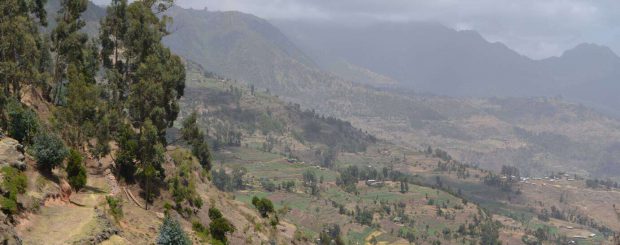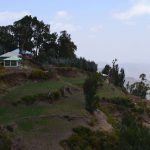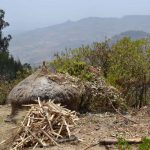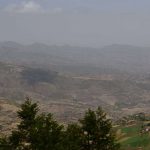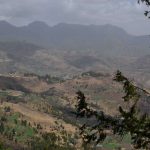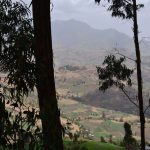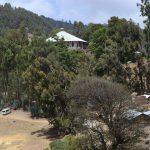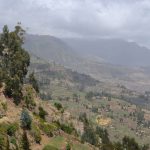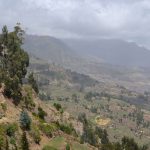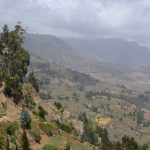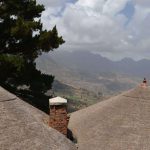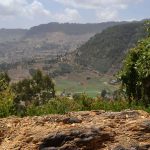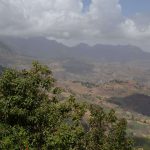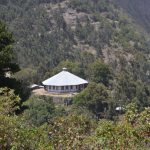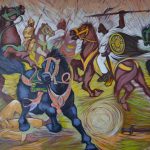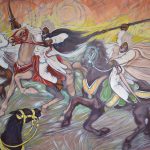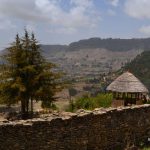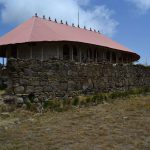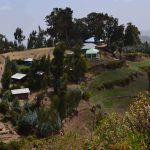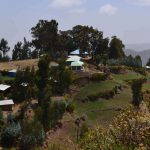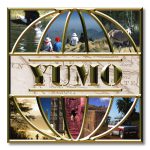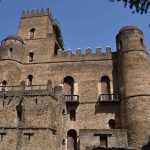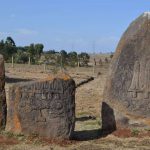The wild rose, the fern, the lantana, and the honeysuckle, smiled round a succession of highly cultivated terraces, and on every eminence, stood a cluster of conically thatched houses, environed by green hedges, and partially embowered amid dark trees As the troop passed on, the peasant abandoned his occupation to gaze at the novel procession; while merry groups of hooded women, decked in scarlet and crimson left their avocations in the hut to welcome the king’s guests with a shrill ziroleet, which ran from every hand. Birds warbled among the groves. At various turns of the road the prospect was rugged, wild, and beautiful. The first Christian village was soon revealed on the summit of a height. Three principal ranges of hills were next crossed in succession. Lastly, the view opened upon the wooded site of Ankober occupying a central position in a horseshoe crescent of mountains, still high above which enclose a magnificent amphitheatre of ten miles in diameter. This is clothed throughout with a splendid vigorous, and varied vegetation.”
– Major W Cornwallis Harris (1843.)
Ankober is approached through undulating countryside, then through more mountainous country including Mt Kundi (3500m), and the maximum elevation of the surrounding mountain peaks is about 12600 ft. (3840m). It is built on the edge of a great escarpment, within a horseshoe crescent of mountains providing panoramic views of Mt Imemihret or Fiqre Gimb commanding the old trading route to the eastern lowlands, the plains of Afar, Harar, the Great Rift Valley and the coastal ports of Berbera, and Zeyla in the Gulf of Aden. In days gone by, one can imagine that its strategic position must have been a formidable defensive stronghold, and it is no surprise to learn that it was once the site of an imperial palace, and the old capital of Shoa region, which was expanding but relatively stable during the turbulent Era of the Princes.
Founded by King Amha Iyesus (1744-1775), and strengthened by his son King Asfa Wossen (1775-1807), the town grew into a principal residence of King Sahle Selassie (1813-1847) and the court received many foreign dignitaries, including in 1841-3 British Major W Cornwallis Harris (Bombay Engineers) and Captain Douglas Graham (Bombay Army) who travelled in a hazardous overland caravan from the port of Tadjoura. Three times a year, caravans used to depart for the ports of Berbera and Zeyla laden with ivory, ostrich feathers, ghee, saffrons, gums & myrrh, in exchange for blue and white calicoes, Indian prints, silks and shawls, red cotton yarn, silk threads, beads, frankincense, copper wire and zinc.
In Ankober, the church of St George was built by Amha Iyesus, in a grove of wild fig and euphorbia trees. His son built the church of St Mary, surrounded by a large bronze cross. Another 3 churches were added by Sahle Selassie. During its occupation by Emperor Tewedros in the 1850s, Ankober declined, but was later rebuilt by Sahle Selassie’s famous grandson, the modernising King Menelik, who used this as his capital until moving to Entoto in 1878, and then to Addis Ababa in 1886. The hill-top imperial site, Angolela, is now the location of a new tourist eco-lodge, and its restaurant tries to recapture the style of the great hall. In the surrounding countryside, keep a sharp eye open for the endemic Ankober Serin.
Social Share
Contact information
Yumo Tours
P.O. Box 5698
Addis Ababa, Ethiopia
++251 11 5518878
++251 11 5513783
++251 11 5513451
info@yumo.net

